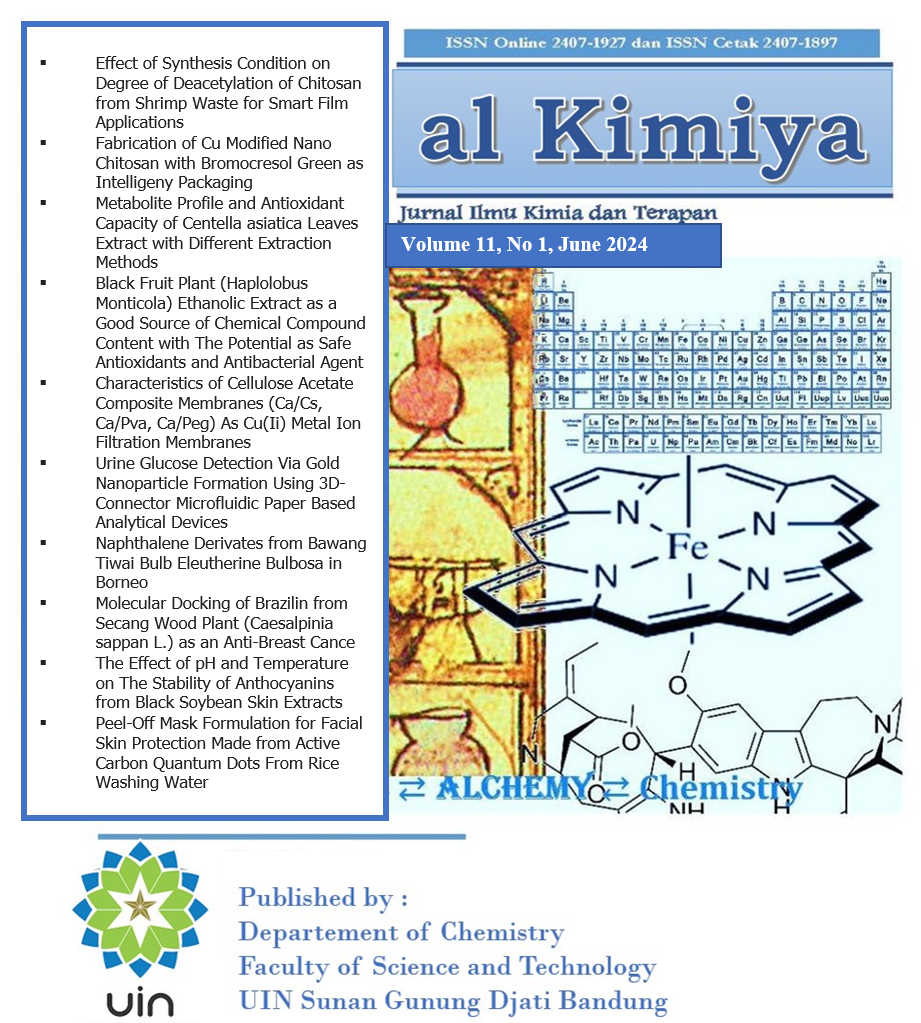Metabolite Profile and Antioxidant Capacity of Centella asiatica Leaves Extract with Different Extraction Methods
DOI:
https://doi.org/10.15575/ak.v11i1.34127Keywords:
Antioxidant, C. asiatica, extraction methods, phenolics, chemometricsAbstract
References
Z. W. Wu et al., “Oleanane-and ursane-type triterpene saponins from Centella asiatica exhibit neuroprotective effects,†J. Agric. Food Chem., 68(26), 6977–6986, 2020,
https://doi.org/10.1021/acs.jafc.0c01476
S. M. Chiroma et al., “Neuro-therapeutic benefits of Centella asiatica on some neurodegenerative diseases: A review,†RJPBCS, 8(6), 549–556, 2017.
D. G. Matthews et al., “Caffeoylquinic acids in Centella asiatica reverse cognitive deficits in male 5XFAD Alzheimer’s disease model mice,†Nutrients, 12(11), 1–9, 2020,
https://doi.org/10.3390/nu12113488
N. E. Gray et al., “Centella asiatica: phytochemistry and mechanisms of neuroprotection and cognitive enhancement,†Phytochem. Rev., 17(1), 161–194, 2018,
https://doi.org/10.1007/s11101-017-9528-y
N. N. M. Nazmi and N. M. Sarbon, “Characterization on antioxidant and physical properties of gelatin based composite films with incorporation of Centella asiatica (Pegaga) extract,†Food Res., 4(1), 224–233, 2020,
https://doi.org/10.26656/fr.2017.4(1).243
E. Arribas-López, N. Zand, O. Ojo, M. J. Snowden, and T. Kochhar, “A systematic review of the effect of Centella asiatica on wound healing,†Int. J. Environ. Res. Public Health, 19(6), 1–13, 2022,
https://doi.org/10.3390/ijerph19063266
B. Sun et al., “Therapeutic potential of Centella asiatica and its triterpenes: A review,†Front. Pharmacol., 11, 568032, 2020,
https://doi.org/10.3389/fphar.2020.568032
T. Belwal et al., “Gotu Kola (Centella asiatica),†in Nonvitamin and Nonmineral Nutritional Supplements, S. M. Nabavi and A. S. Silva, Eds., London: Elsevier, 265–275, 2018,
https://doi.org/10.1016/B978-0-12-812491-8.00038-2
R. Kunjumon, A. J. Johnson, and S. Baby, “Centella asiatica: Secondary metabolites, biological activities and biomass sources,†Phytomed., 2(1), 1–22, 2022,
https://doi.org/10.1016/j.phyplu.2021.100176
E. Skrzypczak-Pietraszek, A. Urbańska, P. Żmudzki, and J. Pietraszek, “Elicitation with methyl jasmonate combined with cultivation in the PlantformTM temporary immersion bioreactor highly increases the accumulation of selected centellosides and phenolics in Centella asiatica (L.) Urban shoot culture,†Eng. Life Sci., 19(12), 931–943, 2019,
https://doi.org/10.1002/elsc.201900051
G. Zengin et al., “Chemical composition and bio-functional perspectives of Erica arborea L. extracts obtained by different extraction techniques: Innovative insights,†Ind. Crops Prod., 142, 111843, 2019,
https://doi.org/10.1016/j.indcrop.2019.111843
P. GarcÃa-Pérez, B. Miras-Moreno, L. Lucini, and P. P. Gallego, “The metabolomics reveals intraspecies variability of bioactive compounds in elicited suspension cell cultures of three Bryophyllum species,†Ind. Crop. Prod., 163, 113322, 2021,
https://doi.org/10.1016/j.indcrop.2021.113322
R. Salazar-Aranda, L. A. Pérez-López, J. López-Arroyo, B. A. AlanÃs-Garza, and N. W. de Torres, “Antimicrobial and antioxidant activities of plants from northeast of Mexico,†Evidence-based Complement. Altern. Med., 2011, 536139, 2011,
https://doi.org/10.1093/ecam/nep127
E. M. Yahia, F. Gutiérrez-Orozco, and M. A. Moreno-Pérez, “Identification of phenolic compounds by liquid chromatography-mass spectrometry in seventeen species of wild mushrooms in Central Mexico and determination of their antioxidant activity and bioactive compounds,†Food Chem., 226, 14–22, 2017,
https://doi.org/10.1016/j.foodchem.2017.01.044
M. Rafi et al., “Total phenolics, flavonoids, and anthocyanin contents of six Vireya Rhododendron from Indonesia and evaluation of their antioxidant activities,†J. Appl. Pharm. Sci., 8(9), 49–54, 2018,
https://doi.org/10.7324/JAPS.2018.8908
M. Palma et al., “Extraction of natural products: Principles and fundamental aspects,†in RSC Green Chemistry, M. A. Rostagno and J. M. Prado, Eds., United Kingdom: Royal Society of Chemistry, 58–88, 2013,
https://doi.org/10.1039/9781849737579-00058
A. P. Febriyanti, S. J. Iswarin, and T. Digjayanti, “Perbandingan kadar asiatikosida dalam ekstrak etanol 70% pegagan (Centella asiatica (L) Urban) dengan metode esktraksi maserasi dan sonikasi secara LC-MS/MS,†J. Farm. UINAM, 4(2), 50–57, 2016.
B. Shahar, N. Dolma, and N. Chongtham, “Phytochemical analysis, antioxidant activity and identification of bioactive constituents from three wild medicinally important underutilized plants of Ladakh, India using GCMS and FTIR based metabolomics approach,†Food Human., 1, 430–439, 2023,
https://doi.org/10.1016/j.foohum.2023.06.022
S. N. H. M. Azmin and M. S. M. Nor, “Chemical fingerprint of Centella asiatica’s bioactive compounds in the ethanolic and aqueous extracts,†ABST, 2, 35–44, 2020,
https://doi.org/10.1016/j.abst.2020.10.001
J. Sugunabai, M. Jeyaraj, and T. Karpagam, “Analysis of functional compounds and antioxidant activity of Centella asiatica,†J. Pharm. Pharm. Sci., 4(8), 1982–1993, 2015.
D. Puspitasari, F. F. Anwar, and N. G. A. Faizah, “Aktivitas antioksidan, penetapan kadar fenolik total dan flavonoid total ekstrak etanol, etil asetat, dan n-heksana daun petai (Parkia speciosa Hassk.),†JITEK, 5(1), 1–8, 2019,
https://doi.org/10.26877/jitek.v5i1.3490
D. L. Pavia, G. M. Lampman, and G. S. Kriz, Introduction to Spectroscopy, Third Edit. Washington: Thompson Learning Inc., 2001.
A. B. D. Nandiyanto, R. Oktiani, and R. Ragadhita, “How to read and interpret FTIR spectroscope of organic material,†Indones. J. Sci. Technol., 4(1), 97–118, 2019,
https://doi.org/10.17509/ijost.v4i1.15806
E. D. Purwakusumah, M. Rafi, U. D. Syafitri, W. Nurcholis, M. Agung, and Z. Adzkiya, “Identification and authentication of jahe merah using combination of FTIR spectrocopy and chemometrics,†AGRITECH, 34(1), 82–87, 2014, doi: 10.22146/agritech.9526
I. Andriansyah, H. N. M. H. Wijaya, and Purwaniati, “Analisis adulteran pada kopi luwak dengan metode fourier transform infrared (FTIR),†J. Kim. Ris., 6(1), 26–38, 2021,
Downloads
Published
Issue
Section
Citation Check
License
Authors who publish with this journal agree to the following terms:
- Authors retain copyright and grant the journal right of first publication with the work simultaneously licensed under a Creative Commons Attribution 4.0 International License that allows others to share the work with an acknowledgment of the work's authorship and initial publication in this journal.
- Authors are able to enter into separate, additional contractual arrangements for the non-exclusive distribution of the journal's published version of the work (e.g., post it to an institutional repository or publish it in a book), with an acknowledgment of its initial publication in this journal.
- Authors are permitted and encouraged to post their work online (e.g., in institutional repositories or on their website) prior to and during the submission process, as it can lead to productive exchanges, as well as earlier and greater citation of published work (See The Effect of Open Access).

